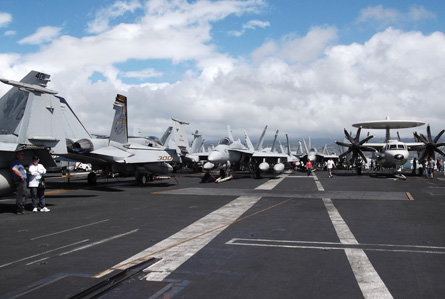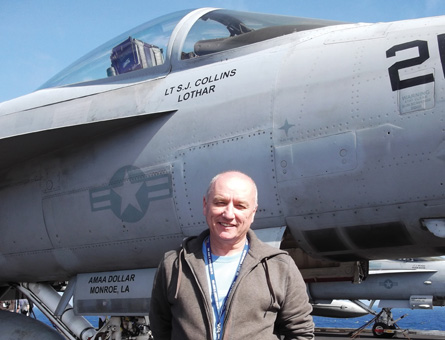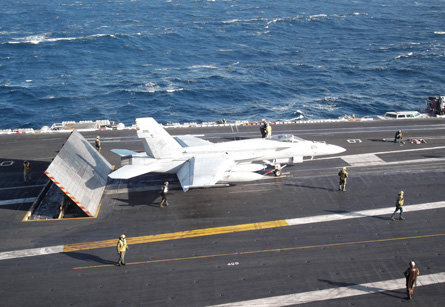Stick or twist? That is the choice facing UK defence secretary Philip Hammond, who is poised to announce a decision on the future of the nation's carrier strike ambitions and choice of embarked combat aircraft.
The main issue to be decided is whether to keep faith with a decision made in late 2010 to switch allegiance from Lockheed's short take-off and vertical landing F-35B to the manufacturer's C-model carrier variant. Attributed at the time to a desire to acquire the stealthy aircraft in its "more capable, less expensive and longer-range" version, the act has had massive cost implications for the Royal Navy's future aircraft carrier programme at a time of severe budget-tightening.
Studies continue to determine the likely price of adapting one or both of the UK's future carriers to accommodate an electromagnetic launch system and arresting gear to support operations with the F-35C, but the possibility of Hammond soon approving a switch back to the STOVL aircraft appears a real one, given his determination to balance the Ministry of Defence's finances.
 |
|---|
| © Peter Collins/Flightglobal The USS Stennis carries in excess of 70 aircraft at any one time |
By the time of the first vessel's introduction, the RN will have lacked an operational "large-deck" carrier for more than 40 years since decommissioning the Audacious-class HMS Ark Royal, and the service by no means underestimates the challenge faced in regaining such a capability.
Flight International test pilot Peter Collins had a rare chance to witness fixed-wing operations at close hand in late February, when he spent seven days on board the US Navy's Nimitz-class aircraft carrier the USS John C Stennis (CVN 74). He joined the vessel as Carrier Strike Group 3 made its way home across the Pacific at the end of a seven-month tour of duty in the Persian Gulf and Arabian Sea, from where it had provided air support to coalition forces in Afganistan and Iraq.
EXPERT OPINION
Collins - a former military fast jet pilot and test pilot with past experience on the Harrier GR3, Sea Harrier FRS1 (on HMS Illustrious) and the UK's experimental VAAC Harrier, built to aid the development of the F-35B's flight control laws - used the opportunity to assess whether a flat-deck aircraft carrier could be considered an "airfield at sea", and in any way compare to the operations of a land-based, air force wing.
His visit was also intended to highlight some of the challenges that the RN and Fleet Air Arm will face as they prepare to introduce future carriers HMS Queen Elizabeth and HMS Prince of Wales, particularly if the F-35C is retained.
 |
|---|
| © Peter Collins/Flightglobal Test pilot Peter Collins onboard the USS Stennis |
Collins's hosts were the USN's VFA-14 "Top Hatters" squadron, which flies the single-seat Boeing F/A-18E Super Hornet and is commanded by Cdr Kevin McLaughlin. Other elements of Carrier Air Group (CAG) 9 were a squadron of two-seat F/A-18Fs and two squadrons of F/A-18C Hornets, which together made a force of more than 40 attack aircraft. Also on board were individual squadrons of Northrop Grumman EA-6B Prowler electronic warfare, Northrop E-2C Hawkeye airborne early warning and control and C-2A Greyhound cargo delivery aircraft, plus Sikorksy MH-60R Seahawk anti-submarine warfare and MH-60S plane guard helicopters. In all, the air group totalled in excess of 70 aircraft and operated as a self-contained expeditionary air wing.
With a total crew of over 5,000, the Stennis is nuclear powered and displaces over 100,000t, making it much larger than the UK's 65,000t Queen Elizabeth-class ships. It has four side lifts rising from the hangar to the flight deck, an angled deck at the port waist and four steam-powered catapults: two at the bow and two at the angled deck.
LANDING SPACE
But for all its total size, the carrier's angled deck, with four arrestor wires, only measures 786ft (240m) in length and 114ft in width between the painted side "foul lines". From the stern "round down" to the first arrestor wire is 170ft. The arrestor wires are spaced about 40ft apart, with the number three wire being the target that any pilot will aim to catch. A typical approach speed for a mid-weight F/A-18E/F is 140kt (259km/h) indicated air speed, flown at an 8.1˚ angle of attack (AoA).
Aircraft, ground equipment and deck personnel are parked/positioned on both sides of the angled deck landing area and just outside the foul lines. The proximity of landing aircraft to potential obstructions is swiftly apparent, with a Hawkeye's wingtip only 4ft inside the foul line when landed precisely on the deck centreline.
The mechanics of arresting a high-speed fast jet on a deck landing area that is typically less than one-tenth the length of a conventional runway also impresses, particularly as it requires a pilot to catch a wire accurately from a precisely flown approach onto a pitching, heaving and rolling deck. A landing aircraft must also be cleared beyond the foul line and the deck prepared to accept the next arrival within just 55sec.
With aircraft being positioned after landing, others being readied for the next launch and more being armed or moved between deck and hangar, the organisation of the air group around the carrier requires an extraordinary level of co-ordination and control. The hangar space, although large and unobstructed along its length, appears akin to a labyrinth full of aircraft with overlapping wings, tailplanes, rotor blades and propellers, and with maintenance crews working within very confined spaces.
 |
|---|
| © Peter Collins/Flightglobal |
The choreography of air group support on the vessel's deck sees personnel work within "coloured vest" specialisations to direct aircraft to taxi within inches of each other and the deck edges. They also operate quickly and smoothly across a flight deck surface live with jet intakes and exhausts, turning propellers, extending and retracting arrestor cables, operating catapults, open armament and aircraft lifts and many other potential dangers. Their ability to do so is the product of hard-earned experience, strict adherence to procedures and the currency of unbroken operations. This normal deck tempo was maintained during a 12h uninterrupted shift over a six-day week, for up to two months at a time without a break.
The carrier, meanwhile, must co-ordinate its launch and recovery operations with escorting vessels to negate surface, sub-surface and above-surface threats, maintain navigational integrity with regard to obstacles or territorial borders and avoid weather that could compromise flight operations. These factors add layers of operational complexity not encountered by an air force base or station headquarters.
MANUAL LANDINGS
Landing guidance in poor weather or at night can be provided by the advanced carrier landing system, which datalinks information from the ship, or the older antenna-based instrument carrier landing system, and with aircraft using the options of autopilot or auto throttle coupling, if so equipped. But since these auto-systems do not have the same levels of multiple redundancy found in civilian commercial aircraft, they cannot be relied on operationally and cannot always compensate for deck movement. As a result, the great majority of landings are still made fully manually, placing critical importance on the ship's Landing Signals Officers (LSOs), known colloquially as "Paddles".
Each LSO team of around four to six personnel works as a fully integrated unit. Some of these look exclusively at the aircraft, while others view the deck to ensure that it is not fouled. They are backed up by a system of deck lights and radio calls from the Flying Commander, or "Air Boss", to "gate" the landing aircraft at the 100ft and 10ft "wave off" heights. Airspeed, angle of attack and pitch attitude of an aircraft, along with its height on crossing the round down point, are all critical to the landing hook accurately engaging the number three wire.
Using this system, the LSO team will see approach problems developing externally before the pilot recognises them, and give instant correction instructions to improve landing accuracy, safety and pilot confidence.
For the pilot, meeting a landing slot and matching fuel planning requires ongoing calculation throughout the flight, and especially during extended strike sorties, unlike when making a direct recovery to a land base as a singleton or as part of a small battle formation.
Aircraft are recovered into a vertical "stack" above the ship as per standard operating procedures, which place the F/A-18C lowest and E-2C highest. An individual Super Hornet is normally stationed above the stack to act as a tanker, but its fuel offload is limited and could not hope to cover a strike package numbering over 20 aircraft, or if the air group was in the mid-Atlantic with no diversion airfields available.
KNOWLEDGE RETENTION
The "push down" of aircraft within the stack as others descend or break over the ship and turn to land is decided and conducted by the pilots themselves, without radio transmissions or direction from any shipboard air traffic control.
Tactics, latest intelligence on threat systems and weapon employment recommendations across the squadrons are standardised across the navy's carrier air groups through the service's Fighter Weapons School (still nicknamed "Top Gun") via monthly updates. The USN's squadron structure also ensures that corporate knowledge of aircraft and tactics is properly interwoven and self-sustaining.
 |
|---|
| © Lockheed Martin |
Both represent vital functions that the re-configured Fleet Air Arm will need to build, into its future fixed-wing strike fleet organisation.
Establishing a large deck carrier capability with US-style complexity cannot be 'worked up' by using helicopters as an initial option. This means that a decision to keep with the F-35C and converting at least one of the RN's Queen Elizabeth-class ships could be ably supported by using an interim fixed-wing type, most probably leased.
Such a requirement could come down to a straight choice between the F/A-18E/F or Dassault's Rafale M, with the latter considered due to the UK's strengthened military co-operation with France. Both are affordable and capable multi-role aircraft which are available and flying operationally from carrier decks today, and could fill any gap in capability should the F-35C be delayed further. A first Fleet Air Arm pilot has already gained combat experience in flying the single-seat Super Hornet from the Stennis. Others will also take similar exchange posts with the USN, while more are due to fly the Rafale under a recent agreement.
A decision to revert to the STOVL F-35B would pose more of a challenge, with the UK having already retired its Harrier GR7/9 fleet and sold the surplus aircraft to provide spares for the US Marine Corps.
The recruitment and training of all of the specialist carrier air group trades will be a massive future undertaking for the RN, but also the key to allowing its carriers to function effectively, safely and at the correct operational tempo.
It is vital that the UK does not try to reinvent the wheel in reintroducing its languished carrier strike mission from around 2020; it should instead use the template that the USN provides and read this experience across almost directly.
Even in peacetime the expeditionary ethos of the USN's carrier air group is almost totally different to that of a land-based air wing, and also far removed from the RN's previous small and STOVL-optimised carriers, the last of which, HMS Illustrious, will remain in use as a helicopter assault ship through 2014.
Regardless of the aircraft that will be flown from their decks while in service, the UK's future large carriers will bear almost no similarity to a base on land, and any attempt to label them as "airfields at sea" would be mistaken.
Source: Flight International























